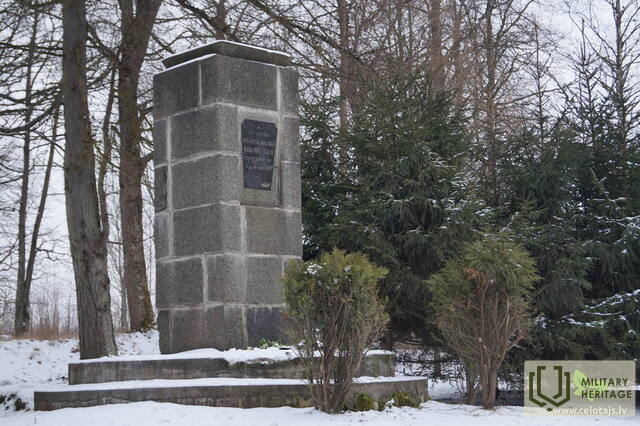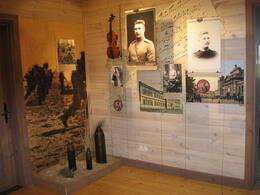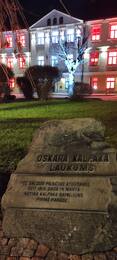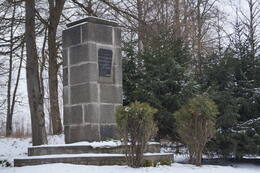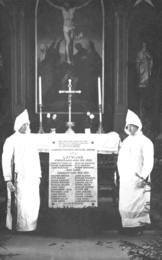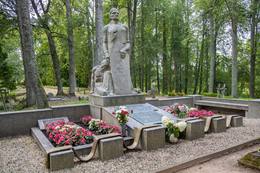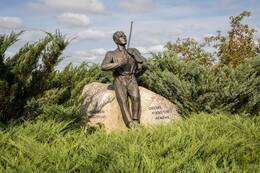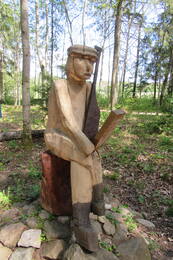Битва при Оскарском батальоне калпаков под Лиелауце
15.janvāra naktī Kalpaka bataljons izcīnīja pirmo kauju pie Lielauces, atsitot sarkano uzbrukumu. Tā bija pirmā nozīmīgā Kalpaka bataljona kauja, kad uzvara karavīriem deva īpaši spēcīgu morālu stimulu.
Kalpaka bataljons tālajā 1919. gadā Lielaucē uzturējās tikai trīs dienas, taču Latvijas vēsturē šī kauja palikusi kā ļoti nozīmīgs mirklis. “Militārie spēki bija nelieli, daļa Latvijas armijas bija Vācu armijas sastāvā, kad Sarkanā armija ar milzīgu pārspēku ienāca Latvijā. Pateicoties rūpīgam izlūku darbam, šī cīņa bija īsa, bet asiņaina, kas sākās pēc pusnakts, pieļaujot abām pusēm kļūdas, - „sarkanie”, redzot Kalpaka bataljona atstātās gaismas pils 2. stāvā, varēja identificēt uzbrukuma mērķi, taču divi, - tālāk uz Dobeles pusi noliktie, karavīri pamanīja uzbrucējus, lai arī bija dziļš putenis un arī raķešu pistole nenostrādāja, aizskrienot un pareizi brīdinot, kaujai nebija pārsteiguma fona. Pirmais kritušais bija leitnants Pēteris Dambītis, jo karavīra zābakus postenī bija nolicis blakus, līdz ar to nepaspēja tos uzvilkt… Kalpaka bataljons netika sakauts arī „sarkano” neizdarībai, jo pārspēks bija trīs reizes lielāks, - karavīri, kas uzbruka, nebija ievērojuši, ka ložmetēju stobrā ūdens ir sasalis, tas arī palīdzēja šo kauju uzvarēt (..). Tā par Kalpaka pirmo kauju piemiņas ceremonijā Lielaucē (~ 2015. gadā) stāstīja Latvijas zemessardzes veterānu apvienības priekšnieks majors Ilgvars Baumanis.
Auces novada TIC, 30.09.2016
Susijusios vietos
Мемориальный музей Оскарса Калпакса «Айритес»
Музей Оскарса Калпакса «Айритес» расположен между Салдусом и Скрундой, недалеко от автомагистрали A9. В экспозиции представлена обширная информация о полковнике Оскарсе Калпаксе и его батальоне, показана история создания Латвийской национальной армии и мемориального комплекса «Айритес». Экспозиция музея раскрывает полковника Оскарса Калпакса как личность, как солдата и борца за независимость Латвии. Экспозиция дополнена записями воспоминаний в аудиоформате (на латышском, английском, немецком языках). Они выделяют важность исторических событий 1918/1919 гг. для защиты латвийской государственности. Здание музея отреставрировано. Вход свободный, экскурсия с гидом платная. Можно посетить зону отдыха, парк, полосу препятствий, различные занятия. Имеется зал для семинаров до 30 мест.
Мемориальный камень на площади Оскараса Калпака в Салдусе
Площадь О. Калпака расположена в самом центре Салдуса, на пересечении улиц Лиела и Стрику.
Бывшая рыночная площадь сегодня является излюбленным местом отдыха жителей и гостей Салдуса, где проводятся концерты, памятные мероприятия и праздники. 10 марта 1919 года Салдус стал первым латвийским городом, освобожденным батальоном полковника Оскара Калпакса.
14 марта 1919 года на площади состоялся первый парад латышского отдельного батальона, а в 1992 году в честь полковника Калпакса площадь была названа его именем.
Памятник, посвященный первому бою батальона Оскара Калпака в Лиелауце.
Он расположен недалеко от руин лютеранской церкви Лиелауце.
19 августа 1934 года возле Лиелауцкой лютеранской церкви был открыт памятник из серого гранита на месте первого боя батальона Оскара Калпака. Мемориал создан по проекту архитектора П. Дреймани. Битва за Лиелауце произошла в ночь с 15 на 16 января 1919 года между калпаками Чеса и Офицерской ротой с одной стороны и солдатами 2-го стрелкового полка. В начале 1950-х памятник был разрушен, но восстановлен в 1991 году.
Мемориальные доски лубанцам, погибшим в Первой мировой войне и Освободительной войне в Лубанской лютеранской церкви
Находится в Лубане, на улице Базницас 1, в лютеранской церкви.
Беломраморная мемориальная доска полковнику Оскару Калпаксу была установлена в церкви Лубаны в межвоенный период "урожденный Хуго Целминьш.
Материалы об Оскаре Калпаке и Хьюго Целминьше ежедневно можно увидеть в экспозиции Лубанского центра культурного наследия и туристической информации.
The last resting place of Colonel Oskars Kalpaks
Located in Visagala Cemetery, Madona district
On July 10, 1927, a monument made by Kārlis Zāle and Arnolds Dzirkaļs was unveiled to Oskars Kalpaks - a composition of three figures, in the center of which is an ancient Latvian warrior with a shield and a sword in his hand, but on both sides is a wielding soldier. At the foot of the sculptural group, a bronze plaque is placed on the granite base, with a text engraved on it, which also includes a poem by Edward Virza dedicated to Kalpak.
Oskars Kalpaks fell in 1919. On March 6, near "Airīte", on the side of Skrunda - Saldus road, on September 18, his remains were transferred from the northern cemetery of Liepāja to the family cemetery in Visagala.
The monument was unveiled by General J. Balodis, Chairman of the Monument Committee of Colonel O. Kalpaks, with the participation of the then President G. Zemgale, Prime Minister M. Skujenieks, Speaker of the Saeima P. Kalniņš, Minister of War R. Bangerskim and K. Ulmanis. The foundation stone of the monument was laid on June 19, 1925. The stone for the monument is taken from the colonel's native house in Siena swamp, O. Kalpaks loved to play the violin on this stone as a child.
The birthplace of Colonel Oskars Kalpaks “Liepsalas” and the final resting place in Visagals cemetery
The Colonel Oskars Kalpaks family memorial in Liepsalas is located in the area between Madona and Lake Lubāns. Liepsalas is Kalpaks’ childhood home. The memorial site was established here in 1997 based on the ideas and using the resources of the colonel’s niece, Ārija Kalpaks-Grundmane (1922-2006). The site consists of various environmental objects and stone sculptures with a symbolic meaning, signifying Latvian ethical and patriotic values. The largest building houses an exhibit dedicated to the history of the Latvian War of Independence and the 22 years of Latvian freedom (1918-1940). Located in the Visagals graveyard, the monument to Oskars Kalpaks, created by Kārlis Zāle and Arnolds Dzirkals, was unveiled in 1927. The monument consists of a composition of three figures, in the centre of which is an ancient Latvian warrior holding a shield and a sword, with a falling soldier on each side. Placed obliquely on a granite base, a bronze plaque at the foot of the sculptural group contains engraved text, including a poem, dedicated to Kalpaks, by Edvards Virza. Oskars Kalpaks died on 6 March 1919 near Airītes, by the road from Skrunda to Saldus.
"Nature - Strength Trail" of Oskars Kalpaks Museum
The nature trail was created in the territory adjacent to the museum and is based on the idea of the design of the O. Kalpaks Museum and its surroundings in 1936.The nature trail is free of charge for individual museum visitors.
The nature trail features wooden sculptures created during a woodworkers' plein-air workshop organised by the Kuldīga Technology and Tourism Technical School on the unifying theme - "For the Love of Freedom". Also on display are large-format paintings from the plein-air "Guard your Fatherland!" artworks painted by teams of schoolchildren from the surrounding regions.
A mini-air-track has also been created in the nature trail for the youngest visitors of the museum.
The first battle of Lielauce Castle and the Oskars Kalpaks battalion
The Lielauce Manor with its park is an object that is associated in Latvian history with the First Battle of Kalpaks, which took place during the War of Independence in January 1919, and its victory. The current manor building ensemble was basically formed at the beginning of the 19th century. The manor house was originally built in the Empire style as a two-story building with a tiled roof. The farm buildings of the complex are located further away from the manor park. The manager's house, which was later rebuilt into a cultural center, stables, a servants' house, and an ice cellar on the pond side, have survived. Only the foundations of the granary built in 1801 remain, but the volumes of the cone kiln, although rebuilt, have been well preserved. The manor's cart house or soldiers' barn can also be viewed.
After the establishment of the Latvian state, the Lielauce Manor building with the adjacent lake, park, buildings and a certain area of forest was first transferred to the establishment of an orphanage, but it was not established. In November 1926, the Forestry Department of the Faculty of Agriculture of the University of Latvia took over the Lielauce Castle, granted by the Central Land Committee for the organization of training practices, with its park and land of 59 hectares. After the Second World War, until 2009, there was a Lielauce Primary School here, but at the same time also a LLU service hotel. Currently, the manor and park are owned by SIA “Mudia”. Until the technical condition of the manor is improved, it is not available to visitors.
On the night of January 15, 1919, the Kalpaks Battalion fought the first battle at Lielauce, repelling the Red attack. It was the first significant battle of the Kalpaks Battalion, when the victory gave the soldiers a particularly strong morale boost.
During the retreat, on January 12, the Latvian separate battalion reached the Lielauce Manor Castle and settled there to rest, setting up guard posts on the surrounding roads. Early in the morning of January 16, the guards noticed the enemy approaching along the Dobele highway and managed to warn those in the castle. The first to engage in the battle was the Officers' Reserve Company, which had taken up positions near the manor building. The Cēsis Company, divided into two parts, tried to surround the enemy. At first, the Bolsheviks retreated, but then they launched a counterattack, which the Cēsis Company managed to repel. The enemy was forced to retreat. The first victory against the Bolsheviks had been won. Although the Kalpakians suffered four casualties (Lieutenant Kārlis Dambītis, Lieutenant Fridrihs Liepa, War Clerk Vilis Cīrulis and Instructor Jānis Būvmeistars) and eight wounded, the outcome of the battle encouraged the soldiers to continue fighting the enemy. Unfortunately, on the same day, the Latvian Separate Battalion was forced to abandon its positions, as the German Raeden Company lost the battle at Vecauce and retreated.




